Our rookie racer is now qualified and ready to race. Click here to read his racing blogs!
The final shakedown test in our Scarab race car – 26 March 2012
You don’t race over the winter. It’s a time to regroup and recoup, to get your car ready for next year and to frantically save as much cash as possible. It’s lucky I did, too. As you can see from the amount spent so far, the coffers are getting perilously low.
Since my car has taken quite a bit of abuse during 2011, it was in need of a bit of a refresh. The engine and gearbox were tired, so would need rebuilding (circa £600 and £350 respectively). I also needed some new seatbelts as the ones on the car are out of date, so wouldn’t pass scrutineering when it comes to my first race. I also needed a transponder (£366 from HS Sports) to enter the Formula Vee championship. That’s a little box that is wired into the car and allows race control to see exactly where you are on the track. It’s used for timing of qualifying laps, meaning the race organisers can see who’s fastest and determine the starting grid order for the race.
Thankfully, as discussed before, race engineer Andy Storer knows a thing or two about preparing race cars. He took on the task of arranging the above and getting my Scarab race-ready for the 2012 season. His labour charge was around £250 for all of the work.
Once all that was done it was time to go testing again to run in the engine and hopefully to try and remember how to drive the car. For convenience I’d decided Silverstone was the best place to go since I know it well, it’s my home track and of course, the first race is there.
To the track!
I arrived at Silverstone at 8am and Andy was already there – along with what seemed like the entire United Kingdom. It was seriously busy. My garage alone had four cars in it – an old American V8 muscle car, a Formula 3 car, an historic Surtees Formula 5000 and my little Scarab.
Split into five sessions, the programme for open-wheel cars consisted of three 30-minute periods in the morning, then one 30- and one 45-minute session after lunch. It wasn’t a case of just going out there hell-for-leather though. I had a new engine and a new gearbox to bed in.
To run the motor in sounds like a fairly simple process, but in reality it began as quite a challenge. To start with I had to keep revs below 4500rpm, yet high enough to prevent the car ‘labouring’. This meant I had to keep it ‘on the cam’ – or in the part of the rev range where the race-tuned engine was happiest. It effectively meant I had between 500-700rpm to play with, making me a very busy boy indeed behind the wheel. Coupled with trying to keep an eye on traffic around me – no mean feat with some cars weighing the same as mine yet having six times my horsepower – it tested my concentration levels to the hilt.
I did a single installation lap and came back to the pits for Andy to make sure the car looked OK and that nothing was leaking. Then I went out again, doing around 10 laps in between a couple of red flags.
In the next two sessions we dialled it up a bit, hiking the revs up in 500rpm increments every ten laps until just before lunch when I was changing at the optimum 6500rpm.
During the lunch break Andy sorted the engine timing, making sure the car was running in exactly the optimum set-up. A few careful twists of the distributor later and he was happy.
During the next period on track it became easier and easier, and by now I could tell the car had been markedly improved since my last test. It felt more eager, seemed to rev more freely, and swapping between gears also felt far more positive. The overall impression was that the car had been significantly upgraded, and my lap times began to reflect this.
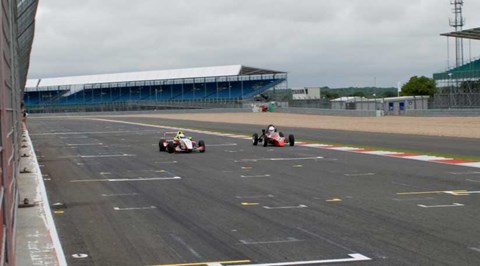 Silverstone’s National Circuit was full. Every garage was occupied and that meant there was a lot of traffic on the track. For the most part of the day it was nearly impossible for me to post a lap time without having to take some sort of avoiding or evasive action, but as time wore on I felt more and more settled and the speed began to build underneath me.
Silverstone’s National Circuit was full. Every garage was occupied and that meant there was a lot of traffic on the track. For the most part of the day it was nearly impossible for me to post a lap time without having to take some sort of avoiding or evasive action, but as time wore on I felt more and more settled and the speed began to build underneath me.
And then I had a ‘moment’…
My lines seemed to be working and I felt quick, and my confidence was soaring. I was attacking the corners, trying to brake later and get on the power sooner. As I came up the pit straight towards Copse I finally found my limit – I broke way too late into the fastest corner on the track, locked up all four wheels and went into a gigantic spin. I ended up on the racing line, facing the wrong way. I had half a second to collect my thoughts before I saw a Formula Renault (a class of car rapidly becoming the bane of my life) bearing down on me at speed.
I watched his car twitch and break into oversteer as – thankfully – he saw me and took evasive action. By this time I’d awoken my stalled engine, had it in first gear and at the earliest possible opportunity put my foot hard on the throttle, wheel-spinning and steering into the little slide to get myself facing the right way and off again. I then drove back to the pits, keeping an eye on my oil pressure gauge just in case damage had been done. It seemed fine, but I thought it best to return and explain to Andy what had happened. He said he’d seen, and that I’d simply braked too late for the corner. I was lucky – I knew it, he knew it but he explained anyway: if another car had been close to me, it could have been a lot worse. I went out again for a few more laps before yet another red flag, and then the session was over.
Confidence shot then? Did you go back out?
Of course I did! The final period for open-wheel cars was 45 minutes long rather than the 30 minutes I’d been doing earlier in the day. For this one we decided I’d go out until Andy called me in. As the lap count grew I really got into a rhythm, nailing one corner and immediately willing my car up the straights towards the next one. If my brand new belts were any looser I’m sure you could have seen me rocking in the car, trying to eke more speed by any means possible.
When Andy finally showed me my pit board to call me I felt tired but extremely happy with the stint. Pulling into the area outside my garage I flipped off the ignition and Andy came up to the car holding the phone he’d been using to time my laps. He said I’d done 24 laps, and then told me my best time. I knew immediately which lap it was, and it was well over a second quicker than my personal best so far. That’s real progress, and we were both absolutely delighted.
So there we are. It’s been a fascinating build-up over the past 10 months or so, but now there’s only one thing left to do. On 31 March 2012 I’ll be competing in my first proper motor race. Luckily it’s at the Silverstone National Circuit. Of course, I’ll let you all know how it goes. For better, or for worse.
Spent this update: £1820
Spend so far: £9496
Saved over winter: £2000
Cash left: £2504
Test day one part two – after the crash – 13 February 2012
On the last update I left you seconds after I’d hit a Formula Renault race car on the entry into Brooklands bend at Silverstone. Ouch.
My memory picks things up again as I exit the corner at walking pace behind the Renault – shards of carbon from which were still fluttering through the air – and pull over onto the grass behind him.
This was my first test session. Had I screwed up? What went wrong? Who was to blame? How the hell do I get out of this bloody car again? The more I thought about it, the more questions I had…
Then came the shameful wait for the recovery truck’s arrival; for the marshals to plonk my sorry car on the back of a flatbed; and for my lift back to the pits, tail wedged firmly between my legs.
Arriving at my garage, race engineer Andy strolled up to the flat-bed truck I’d arrived in and asked the marshal driving it what had gone wrong. I can’t explain quite how stupid I felt at this point, but the marshal simply said that I’d had a coming together with a Renault and that my car would be along after the next test session had finished so they could get it back safety. ‘Doesn’t look too serious,’ he added with a smile.
How much damage had you done, then?
Getting the car back into the garage, we made a brew and stood around it stroking our chins. The front left tyre was definitely flat, there was sticky black rubber smudged over the face of the wheel and my wrists hurt. It was becoming obvious that my front left wheel had hit his rear right. My car didn’t look too bad, but further inspection revealed I’d bent a steering arm too. My day was over.
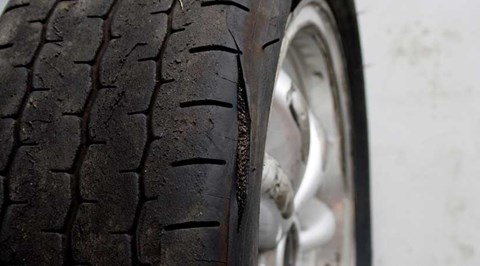 Or so I thought. Andy had the wheel off and got to the offending part, showing exactly how bent it was. Although fairly badly damaged, he was convinced that it was fixable so I let him do his thing. After bending the arm with an adjustable spanner back to a roughly straight profile all looked OK. He had a second-hand tyre which he said I could have for £30, but when it was fitted the tracking was slightly out and Andy didn’t have the gear to fix that. ‘No matter,’ said Andy. ‘We’ll just go and borrow some gear from the team whose car you drove into.’
Or so I thought. Andy had the wheel off and got to the offending part, showing exactly how bent it was. Although fairly badly damaged, he was convinced that it was fixable so I let him do his thing. After bending the arm with an adjustable spanner back to a roughly straight profile all looked OK. He had a second-hand tyre which he said I could have for £30, but when it was fitted the tracking was slightly out and Andy didn’t have the gear to fix that. ‘No matter,’ said Andy. ‘We’ll just go and borrow some gear from the team whose car you drove into.’
As surprising as it is, the team were more than happy to help out. Andy got back with the wheel alignment tools and set up the tracking again, and then I was ready to get back out there. I had two sessions left and what I needed more than anything else was seat time in my car.
Another advantage to Andy going to talk to the other team was that I found out what their side of the story was. The other driver agreed that it was a simple case of two cars trying to fit into space for one. What with the speed differential through the corner he thought he had space so he went for it, and I had to turn in at some point or I’d have gone off the track. I suppose F1 commentators might call it a ‘racing incident’.
Lunch came and went, and soon enough it was time to get back out there again.
Had you learnt from your mistakes?
It was certainly a baptism of fire. The next session out I was conscious of other cars around me in a way I’d never been before. I reckon I must have spent at least 50% of my time looking in my mirrors, terrified that I was going to have another, more serious ‘coming together’ with someone else. As the laps flew by I popped into the pits a few times to check the repairs were holding and that my tyre pressures were OK. I was pleased to hear my lap times were falling rapidly. When the chequered flag came signifying the end of the session out I pulled into the pits feeling several thousand times more confident than I had just 30 minutes before.
While I waited for the fourth and final open-wheel session I studied a map of the circuit and talked with Andy about how I could be taking corners better, and why I’d learned different lines to the other people on track when I took my ARDS test. In what felt like a few minutes (it was 45) it was time to get back out on track and try again.
My first few laps went without incident, and for the first time I could actually feel the tyres warming up and ‘coming to me’. I pulled in for a pit-stop and Andy, who had been recording my times, took the tyre pressures down to get a bit more grip going.
Out again and I really began to feel this racing lark falling into place. I nailed a few corners, coming onto the power nice and early and with just the right amount of steering input, but the car was capable of more. I turned up the speed again, braking as late as I dare and for the first time felt a four-wheel drift come together going into Maggotts.
As my confidence built my times were tumbling, and soon enough Andy was on the pit wall calling me in. When I rolled into the pits he said to me ‘I pulled you in because you just did two very quick laps and I don’t want you going too mad’. I caught my breath, had another tyre check and I was back out for what would be my last few laps of the day.
When the chequered flag flew for the final time I returned to the pits, unclipped my belts and wrestled myself out of the car. Andy told me my quickest time as I took my helmet and gloves off. I was simply astonished at how much I’d come on in just one day; shaving eight seconds from my first times of the day on a track that typically takes around 1min 10sec to lap.
There’s still quite a way to go, but I walked out of garage 3C that day with the biggest grin I can ever remember wearing. Totally hooked.
Spend this update: £30
Spend so far: £7676
Cash left: £2324
Time for our first test day – 26 January 2012
I had the kit, I had the Formula Vee Scarab race car and I had the licence. Better get out there and use it then.
Race engineer Andy suggested I’d be best doing my first test at the same track I did my licence. The reason was simple: better to learn the car at a track you’re familiar with rather than learning both at the same time. Hence the venue would be the home of British motor racing, Silverstone.
Checking the circuit’s website I found the next date available and called to book. It was a Friday, so I booked a day off work too. After a brief chat with Andy it became clear that the £225 I’d paid for the test day wasn’t the only investment required.
There’s one certainty when going racing in the UK – at some point you will get wet. In case of rain I’d need to get myself some de-mister for my helmet. ‘If it starts raining,’ explained Andy, ‘and you’re doing 120mph down the pit straight, you really want to be able to see where you’re going.’ Fair point.
Another cost was a garage space at Silverstone. Although not strictly essential as you can set up camp outside, Andy made a good argument for shelling out another £60. ‘If you book it, it won’t rain. If you don’t, it’ll piss it down.’ Furthermore you get privacy, somewhere to plug the kettle in and no wind, so things stay where you put them. Considering I had enough to worry about on the day, it seemed a pretty good idea.
Before I knew it I was arriving at the track at 8am for a 9am start.
Time to jump in and go, then?
Erm… it wasn’t quite that simple. I’m not exactly built like your archetypal racing driver. Getting in and out of my car is difficult. There’s only about seven inches between the bottom of the seat and the steering wheel, and contorting my legs in towards the pedals seemed all but impossible bearing in mind you can’t rest your arms on the fibreglass bodywork.
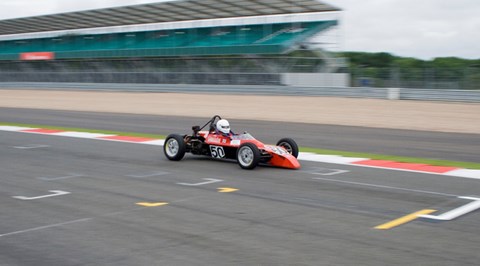 To make matters worse, the fire extinguisher bottle lies on the car floor just in front of the seat. This means if you catch it in the wrong way it’ll go off, and then you’ll need an expensive refill and a hairdryer for your race suit.
To make matters worse, the fire extinguisher bottle lies on the car floor just in front of the seat. This means if you catch it in the wrong way it’ll go off, and then you’ll need an expensive refill and a hairdryer for your race suit.
It’s a surprisingly delicate task, this ‘getting in’ lark. However, I managed it and hopped in and out a few times while Andy got the belts and pedals into the right position. It got easier the more I practised, but I can’t say I achieved anywhere close to what I’d consider ‘finesse’.
Before I knew it I’d had my hour’s preparation and it was time to get going. I got into my Scarab again while Andy showed me how to turn the thing on. After he’s plugged the auxiliary battery into the back it’s a simple case of flicking the ignition switch and pressing the starter button, applying just a touch of throttle. Once the flat-four was pounding happily away I had to keep a tiny amount of pressure on the accelerator to stop the engine from stalling. No idle here… that means more weight!
I slot the gearlever into first with my right hand; luckily I’ve driven abroad quite a lot and easily grasped the subtle change in driving control placement. I gave it a tiny blip of throttle and gently released the clutch pedal, crawling up the pit lane at a snail’s pace; driving my new car for the very first time!
As I reached the end of the pits I remembered to put my arm up to show the marshal on duty the armband I’d been given signalling that I’d signed on and shown my licence to race control. I passed him, now in second gear, rounded the corner and pulled out onto the track, nailing the throttle and setting myself up for the Maggotts/Becketts turn.
Were you the best driver ever to grace Silverstone?
No.
I’ll openly admit I was massively off-line for the first corner. But I made it round and kept going. I was absolutely shocked at how well the Formula Vee S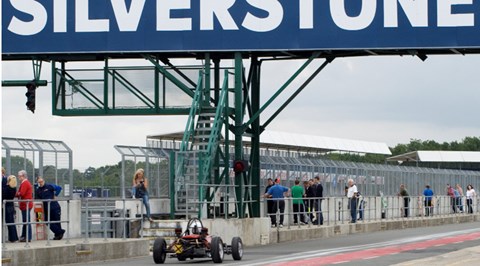 carab drove. For all its foibles and decades-old technology, the way it skated through corners was simply unreal. Never before had I piloted a machine with such a feeling of raw agility and fluid poise. One moment I thought I was at the limit, the next I pushed and found more grip. This car just wanted to go faster and faster. What an incredible rush.
carab drove. For all its foibles and decades-old technology, the way it skated through corners was simply unreal. Never before had I piloted a machine with such a feeling of raw agility and fluid poise. One moment I thought I was at the limit, the next I pushed and found more grip. This car just wanted to go faster and faster. What an incredible rush.
One thing that I’d been worried about before the day was traffic. I was aware that I’d probably be the slowest guy there by quite a margin and fully expected to be overtaken rather a lot. What I wasn’t prepared for though was quite how extreme the speed differential between me and the other cars was. Let me tell you this: a Formula Renault with slick tyres and the full effect of aerodynamics can carve through corners at quite unbelievable speed. For that reason, they sneak up on you in your laughably small and carburettor-dominated mirrors.
To my chagrin I found this out the hard way. Driving into the Brooklands Complex I pulled over to let a black and white car past. Once he was past I turned into the corner and BANG! Turns out there was car behind the black and white one, and we’d crashed into each other. Hard.
Spend this update: £293
Spend so far: £7655
Cash left: £2345
Buying the clobber – the gear you need and how much it’s likely to cost – 29 December 2011
You can’t just rock up at a race track, jump in a car and go racing. You’ll need to shell out for all the right clothing before they let you out on track. This isn’t a fashion thing; it’s more to do with safety. Funnily enough I’m not really up for being burnt alive.
A friend suggested I visit GPR – Grand Prix Racewear – at Silverstone. I called ahead and was told to turn up and ask for Tom. He was a young chap who asked what type of car I’d be racing and what my budget was.
Having done a bit of reading up, I’d decided on a £2000 max spend for my racewear… but I didn’t want him to know that so I said £1500. I didn’t want F1-spec clobber, but I did want to be safe, and crucially, to pass scrutineering when I finally get around to racing.
Sounds good, but where do you start?
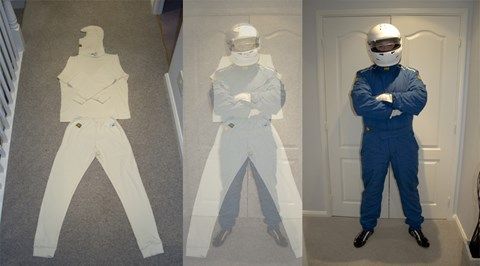 The first thing to look at was a race suit. There are myriad options, but luckily Tom was there to guide me through. For cost reasons I decided against a triple-layer version and went for a twin-layer suit from OMP. The only difference between the two is the amount of fire protection on offer.
The first thing to look at was a race suit. There are myriad options, but luckily Tom was there to guide me through. For cost reasons I decided against a triple-layer version and went for a twin-layer suit from OMP. The only difference between the two is the amount of fire protection on offer.
Now, you wouldn’t think colour was a consideration in my ‘beggars can’t be choosers’ situation but you’d be wrong. You don’t want black as it gets far too hot. You don’t want white unless you want to look like a certain infamous TV character. I decided on blue simply because that’s what was in stock, and chose an entry-level OMP ‘First 2’ at £312.
Next up is underwear. More important than you may think, Nomex is the material you need if you want to be fireproof. I went for the full set from OMP consisting of – in vertical order – balaclava (£20), top (£54), trousers (£45) and socks (£14).
Now for Gloves. Grip and comfort are the main issues here, so I tried a few on and grabbed a railing in the store to test out the various types of grip. In the end I continued with the OMP theme, choosing its HTG glove (£102) again finished in blue. One of the clever touches this glove has is stitching on the outside – so it won’t rub on your hands when you’ve been wearing them a while.
Racing boots were next on the list. Comfort is obviously important, but the main thing likely to affect your choice is whether you prefer a rigid or a floppy sole. At my novice level it won’t make much difference either way, so I went for rigid soles because frankly, that’s what all my other shoes have. Instead of going for a full smurf-out I chose black shoes just in case I needed to wear them independently of the rest of my gear. I went for Sparco’s Formula SL 7 model at £176, which has the added bonus of a reinforced pad on the side of the shoe to prevent premature wear when heel-and-toeing.
That’s the body sorted. What about your head?
Time to choose one of the most important (and expensive) bits of kit: the helmet. Tom explained that like most things you can pay as much as you want, but there is a minimum requirement for racing. He explained that there are two makes most racers go for; Bell and Arai. The former is around half the price of the equivalent latter, so that’s where my search began. Tom went through the various types, from featherweight full carbon fibre ones to the slightly less extravagant examples. In the end I went for Bell’s RS3 Pro at £474, which Tom assured me was a good compromise between protection, weight and price; and for this reason was ‘industry standard’ for most club-level racers.
Lastly I needed a HANS, or Head And Neck Support, device. Although not compulsory, since they’ve been proven to reduce the risk of head and spinal injuries I thought it would be wise to get one just in case. It’s a carbon fibre device which fits around your neck and connects to your helmet, preventing any excess movement of the head during high G-force situations – such as crashing. You actually pay twice for this; not only do you need the device but you need clips fitted to your helmet by an FIA-sanctioned place like GPR too. The device cost £490, and having the clips fitted cost £64.
So that’s it. Now I had all the gear, it was time to go testing…
Spend this update: £1751
Spend so far: £7362
Cash left: £2638
Taking the plunge – buying the car, how I came to the decision and meeting my race engineer – 2 December 2011
I spent months trawling classifieds websites for race cars. One minute I fancied a Caterfield-type affair so I could have fun on the road and the track. The next I was looking at vintage tin-top racers from the likes of Mini and Lotus. I must have driven my car-loving colleagues absolutely spare.
One thing that really appealed to me was a Ginetta. The G20 could be had within my budget, it’s a British firm and there’s a popular racing championship too – as anyone who has watched the BTCC coverage recently will know. However, there is one rather major consideration to take into account: I have nowhere to keep the car, and I’d need a trailer at the very least since it’s not road legal. This all pushed the cost up significantly, and once I’d investigated how much a season would cost (£7000 without the car or trailer) I deemed it far too expensive.
Just after that I spotted an advert on www.racecarsdirect.com for a single-seat race car called a Formula Vee Scarab. It was up for sale at £5000 and the advert stated that ‘various race packages were available’. I called the number on the advert and had my first conversation with Andy Storer. We arranged for me to go to his premises in Newark and have a chat about what I wanted to do.
Get up to 40% off all Bauer magazine subscriptions in our christmas offer – click here
The Formula Vee Scarab
Arriving at his premises one evening, Andy made me a cup of tea before spending two hours talking me through Formula Vee, his credentials and his own racing experience.
Turns out that although he runs a race car business, Andy also races himself in historic Formula Three, has completed the Le Mans Classic in a pre-war Austin Seven and lectures at a university two days a week on his specialist subject: making cars and their drivers go very quickly around a track.
Furthermore, the car I’d enquired about was a Scarab, and Andy had played no small part in the design of that very car. What I’d stumbled upon was a chap who knows his onions better than pretty much every grocer out there.
He went on to explain the costs involved, and where my hard-earned money would be going.
The haggling bit – yes you must get a deal on a race car!
We agreed on a price of £4500 for the car. It’s a mark two version of the Scarab, using the air-cooled 1.3-litre engine from a VW Beetle tuned to around 94bhp. If that doesn’t sound like a lot, think about this: thanks to its ultra-light weight (minimum weight is 475kg) it’ll lap a track roughly the same speed as a Porsche 911 996 GT3. Not exactly snail’s pace.
One major advantage of signing Andy up as my race engineer was the comprehensive package that he offers. Not only will he maintain (and fix!) the car, but he’ll transport it to tracks for me, keep it locked up in his premises and even offer race tuition when I get to the track. He explained that maintaining the car isn’t anywhere near as expensive as I’ve been used to; engine and gearbox rebuilds can be had for a few hundred quid a pop. Tyres last forever too, especially when you’re just starting out. This sounded promising.
Although not as popular in the UK as series such as Formula Renault and Formula Ford, many top drivers cut their teeth in Vee. Jochen Rindt, the Fittipaldi brothers, Niki Lauda and Keke Rosberg are all former Vee racers.
After a day or so deliberating I agreed to pay Andy an initial payment of £5000. This covered storage at £15 per week for six months, the car ready-to-race and the installation of some new seatbelts as the existing ones were out of date. I contacted my bank, made the transfer and that very day I became a racing car owner.
Spend this update: £5000
Spend so far: £5611
Cash left: £4389
Racing licence part 2: the ARDS test – 1 November 2011
On the morning of my ARDS test I was told to get to Silverstone for 8.30am for the first briefing. In short order we were told that not everyone in the room would be passing – apparently a 100% success rate hasn’t happened on an ARDS course at Silverstone in a very long time.
There was a strong emphasis on safety, with our Super Licence-holding (i.e. F1 qualified) instructor explaining that hypothetically the day after our test he may be racing against us, so it’s in everyone’s interests to make sure you don’t pass unless you can demonstrate you’re a safe driver on track.
We had the racing lines we’d be using explained to us. We were on the National circuit, which is the shortest of the tracks at the Silverstone venue. Although it doesn’t look like it, there are only four corners on this track if you drive it correctly. This makes it perfect for novice racers, because believe me, there’s enough to overwhelm a newbie without having to worry about negotiating 1000 corners a lap.
After the briefing we had our first car control session, which was held in a coned-off parking area, in regular Renault Meganes on castors employed to simulate oversteer. Having driven my share of rear wheel-drive cars in the past, I found the way the car reacted was somewhat exaggerated. As soon as you turned the steering wheel the car snapped immediately out into a slide, meaning you had to correct microseconds after your initial input. Still, from a total novice’s point of view I can see how it would be a good way to learn how to react to a slide.
Sounds fun, but aren’t you meant to be driving on track?
N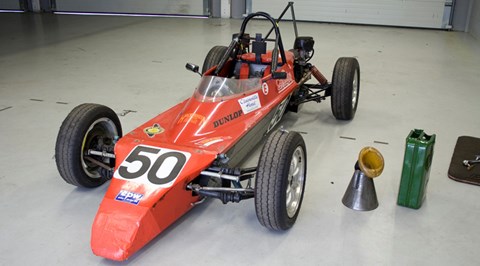 ext came our first session in the car we’d be taking our tests in: the Renaultsport Megane 250RS. With a racing instructor in the passenger seat we began lapping the track, our teacher explaining where we should be placing the car and what we should be trying to achieve at various points on the circuit. There was a lot of information flying around the cockpit of that car, and as the session wore on I don’t mind admitting I began making mistakes as I concentrated on learning both the course and the car. Soon enough it was over, and time to go for lunch.
ext came our first session in the car we’d be taking our tests in: the Renaultsport Megane 250RS. With a racing instructor in the passenger seat we began lapping the track, our teacher explaining where we should be placing the car and what we should be trying to achieve at various points on the circuit. There was a lot of information flying around the cockpit of that car, and as the session wore on I don’t mind admitting I began making mistakes as I concentrated on learning both the course and the car. Soon enough it was over, and time to go for lunch.
After feeding time it was time for the written exam. Split into four sections, getting one question wrong in the first three means an instant fail. Section one was the flags, which I’d made sure I knew backwards. The rest covered racing safety, and wasn’t too challenging if you’d revised beforehand.
Advanced car control came next. You are sat in a Caterham, pointed at a course laid out with cones, and let loose. The idea is to initiate – and then control – drifts. The course included a selection of corners, from hairpins to high-speed right angles, and it was so much fun that when my go was over I didn’t want to get out.
OK, drift king. How did the actual test go?
Unfortunately, playtime was now over and it was back to the serious business of passing the practical aspect of my ARDS test. We were put back into the Renaultsport cars and got a few laps more tuition, and then it was time to show what I was made of. The test comes in the form of a silent passenger – an instructor with a clipboard. He’ll only tell you when to leave the pits and when to come back in, and you have to demonstrate that you’ve absorbed everything expected of you.
It wasn’t all plain sailing for me, and at one point I ended up in a situation where I was one of three cars entering Woodcote corner at the same time. I picked a line and stuck with it, and entered the pit straight hoping I hadn’t screwed up.
After what I’m sure can’t have been more than two laps (it was more like 15), the instructor told me to pull into the pits at the end of the lap I was on. As I was trundling up the pit lane he asked how I thought I’d done. I honestly had no idea, and told him so. As we pulled to a stop he told me I’d passed and a wave of relief swept over me. Another hurdle jumped, and I’m one large leap closer to fulfilling my dream.
The second I could I sent off my application form, complete with that all-important stamp from Silverstone Motorsport Academy. Of course, this calls for another payment. £53 this time. You’ve guessed it; this racing lark ain’t cheap… and I haven’t even decided what type of car to buy yet!
Spend this update: £53
Spend so far: £611
Cash left: £9389
The racing licence part 1 – Go racing pack, medical, choosing an ARDS venue – 24 October 2011
I’d decided I wanted to be a racing driver, so now what? ‘Racing driver’ is a very broad job description. Did I want to rally? Get involved with karting? Go grass-track racing? Hill climbing? There are myriad options out there.
I had to consider what I wanted to get out of all this. As well as craving speed, one of my objectives was to become a better driver. After some investigation and speaking to some people I know in the racing game, I decided the great British race track was where I’d like to spend my time. Whether saloon racing, single-seat competition or even pedalling a classic at ‘revival’ events, I knew it had to be on the black stuff. One problem though: to enter such series, you need a licence.
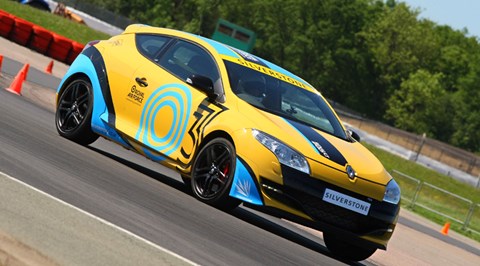 A trip to the MSA – the governing body for motorsport in the UK – website revealed that I’d need to start at the bottom with a National B race licence.
A trip to the MSA – the governing body for motorsport in the UK – website revealed that I’d need to start at the bottom with a National B race licence.
So how do I go about getting a race licence?
According to the website the first step is to purchase a ‘Go Racing Pack’ from the MSA. That’ll be £59. A few days passed as I waited for the pack to arrive. It takes the form of a sort of translucent briefcase-shaped affair containing a blue book, a blue application form, a DVD and a particularly heavy catalogue from a well-known motorsport equipment supplier.
The first task was to arrange to get a medical with my GP. I called and was told that not only would I have to wait a month but I’d have to pay £100 for the medical whether I passed or not. The date approached quickly and suddenly I was walking into my local quack’s office – admittedly fairly nervous having had a month’s worth of psychological build-up.
After an eye test, peeing in a pot and some general prodding and poking (you know the type – she cupped, I coughed) my doc passed me as ‘physically ready to race’. Result.
Having passed my medical I wasted no time with the next stage. The next day I got online and began investigating the ARDS (Association of Racing Drivers Schools) test that must be passed so you can get that all-important signature on your blue form and send off for your licence.
Where can I do an ARDS test?
Most race tracks offer ARDS tests, constituting both written and practical examinations by professional racing drivers. Some tracks offer courses that are cheaper than others, and some offer instruction at high levels than others. I decided to do mine at the home of British motor racing, Silverstone. Once that was decided I had to pick the type of course I wanted to do – there are two options: a half day or a full day. The difference between the two is the full day offers some advanced car control sessions as well as the briefing, track tuition and examination you get with half day course. I decided since I’d have to take a day off work anyway I’d plump for the full day, which costs £399 (the half day is £299).
Unfortunately I was out of the country for the first available date, so found myself having to wait for around six weeks until the big day rolled around.
In the meantime I began revising for the ‘theory’ part of the ARDS, which includes factors such as memorising the MSA flag signals and the safety information you’ll need to know. To do this you just need the Go Racing pack, which contains a DVD out-lining all you need to know and the MSA ‘Blue Book’, which explains the rules of motorsport in the UK in consummate detail.
Spend this update: £558
Spend so far: £558
Cash left: £9442
Why I want to race – 19 October 2011
My name’s Gareth. I’m 27, and I have an addiction. I love going fast.
Throughout my youth I was involved in several activities which let me indulge my habit: I played ice hockey at a fairly high level for many years, and spent a season working as a ski instructor in Canada. However, my first love has always been cars. If I’d got my own way I’d have been racing as soon as I could walk, but like many people who love watching racing, the budget just wasn’t there.
Since learning to drive at 13 with my dad at a local airfield I’ve gone on to own a wide range of performance cars, many of which Japanese, turbocharged, terrifyingly quick and frankly a bit of an assault on my finances. I’ve travelled up and down the country to famous race tracks to feed my passion through track days, but my insatiable appetite for velocity coupled with my irrational love of all things motorsport means I crave more. I need to race.
You’ve gone as far as most enthusiasts go – what’s next?
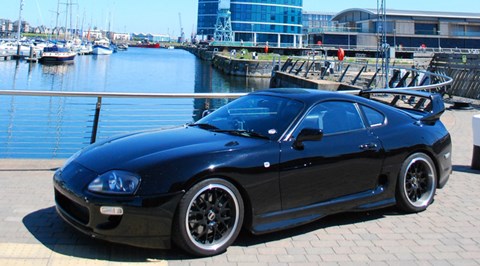 Since I was lucky enough to land a job where I get cars for business and pleasure use, I suddenly had no use for the road car I’d spent the past six years building. It was time to sell my beloved Toyota Supra and take the plunge into something a lot less compromised.
Since I was lucky enough to land a job where I get cars for business and pleasure use, I suddenly had no use for the road car I’d spent the past six years building. It was time to sell my beloved Toyota Supra and take the plunge into something a lot less compromised.
As I prepared the Supra for sale I began the process of deciding what to do with this chunk of extra cash. I’d spent six months trying to sell the car, so had a load of thinking time before the cheque for £10,000 landed on my doormat.
After much deliberation and more than a few reality checks along the way, I chose what seems now to be the only logical step. I’m going to become a racing driver. You’ll be able to follow my progress here over the coming months. More on what car I’ve bought next time…
Spend this update: £0
Spend so far: £0
Cash left: £10,000